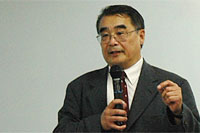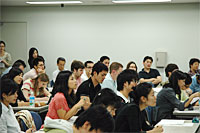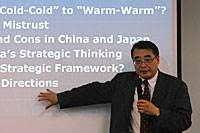Political Integration and Identity
Research:Seminars/Workshops
“Regional Architecture of Security Cooperation” Seminar: “China-Japan Relations and the U.S. Factor” / DR. QUANSHENG ZHAO
2009.06.09
 [GIARI “Political Integration and Identity” Seminar]
[GIARI “Political Integration and Identity” Seminar]
- DR. QUANSHENG ZHAO
- Professor,Internaional relations and Director of Center or Asian Studies,American University, Washigton, DC
- Date: 9 June (Tue), 2009
- Time: 16:20-18:00
- Venue: Room 710, Building 19
- Discussant: Chikako (Kawakatsu) Ueki, Professor, Waseda University
- Organized by: GIARI : Global Institute for Asian Regional Intergration (Waseda University Global COE Program)
Summary of Prof. Zhao's presentation on June 9, 2009
Written by Satoshi Maruyama
June 26, 2009
This presentation aimed at reconsidering China-Japan relations since 1949 and exploring a future ‘Warm-Warm’ relationship between the two states in the light of U.S. factors.
The presentation consisted of five parts: the five stages of China-Japan relations since 1949; mutual mistrust between China and Japan; Pros and Cons, which means the positive and negative factors of each side in their relations; the U.S. factor in Sino-Japanese relations; and the examination of a new strategic framework. The presentation concluded with suggested future directions for both states.
Firstly, China-Japan relations from 1949 to the present were defined in terms of “Warm” and “Cold”. Although a “Cold-Cold” relationship existed between the two states because of the background of the Cold War, it has changed into a “Warm-Warm” relationship at present through the sharing of conflicting political and economic interests.
The second and third parts included historical, economic and political factors. Mutual mistrust emerged from differences in recognition of historical issues that generated anti-Japan demonstrations in China as well as anti-China demonstrations in Japan. In the third part, various historical disputes were discussed including the Taiwan issue, territorial issues, and energy competition in the East China Sea. Although these were seen as negative factors, other issues bringing the two countries together were demonstrated. These included economic interdependency and the East Asian Community, the necessity of political cooperation against North Korea, and improvement of grass-roots communication.
In the fourth part, U.S. strategic thinking on what role the U.S. can play in the China-Japan relationship was discussed. The recent transition of American diplomatic strategy implied that it was possible for the U.S. to mediate in China-Japan relations by engaging with both. The transition came from the necessity that the U.S. has had to cooperate with China on anti-terrorism measures and through the six-party talks on the North Korea nuclear crisis. As a means for better engagement with China for instance, the U.S. lowered Taiwan's position in its diplomatic strategy.
Finally, Prof. Zhao concluded his presentation by suggesting that security cooperation between the U.S. and China, between China and Japan, and between Japan and the U.S. should be strengthened more. He pointed out that the Japan-China relationship was at a crossroads where there were four options ranging from “Cold-Cold” to “Warm-Warm”. While one positive aspect is that grass-roots understanding has been improved, a negative aspect is that Japan hesitates to accept China's proposal for a strategic partnership between the two countries.
Summary[28KB]Photos



